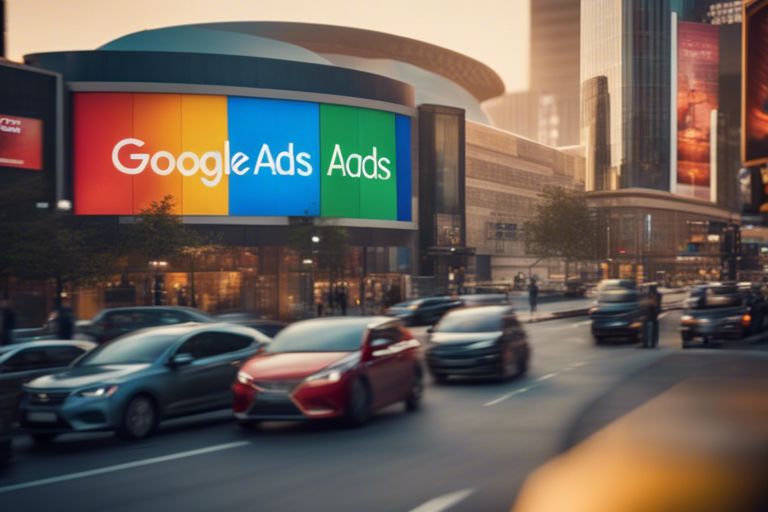Are you looking to take your business to the next level and reach a larger audience? With the powerful tool of Google Ads, you can do just that. Google Ads allows you to effectively target potential customers who are already searching for products or services like yours. In this comprehensive guide, you will learn everything you need to know about using Google Ads to grow your business.
One of the most important aspects of Google Ads is the ability to target your audience specifically. You can target based on keywords, location, demographics, and even time of day. This means that you can ensure that your ads are being shown to the right people at the right time, increasing the likelihood of a successful conversion. Additionally, by using Google Ads, you have the ability to track the success of your campaigns in real-time, allowing you to make adjustments and improvements as you go.
However, it’s important to note that while Google Ads can be incredibly beneficial for your business, it can also be dangerous if not used properly. It’s easy to overspend and target the wrong audience, resulting in wasted time and resources. In this guide, you will learn how to effectively set up and manage your Google Ads campaigns to maximize your results and avoid these potential pitfalls. So, let’s dive in and take your business to the next level with Google Ads.

Types of Google Ads
Assuming you are interested in using Google Ads for your business, it’s important to understand the different types of ads available to you. Here are the main keywords to know:
| Search Ads | Connecting with customers through search queries |
| Display Ads | Visual marketing across websites and apps |
| Video Ads | Engaging potential customers on YouTube |
| Shopping Ads | Driving E-commerce sales |
| App Promotion Ads | Encouraging app downloads and engagement |
| Local Ads | Targeting customers near your business |
After understanding the different types of ads, you can create a strategy that best fits your business goals.
Search Ads: Connecting with Customers through Search Queries
When someone searches for keywords related to your business, your ad will appear at the top of the search results. This is a great way to reach potential customers who are actively looking for products or services like yours. You can target specific search terms and set a budget that works for you. With search ads, you only pay when someone clicks on your ad, making it a cost-effective option.
Display Ads: Visual Marketing across Websites and Apps
With display ads, you can reach potential customers while they are browsing websites, watching videos, or using apps. These ads can be in the form of images, videos, or interactive media, and they appear on Google’s extensive network of partner sites. You can target specific audiences based on their interests, demographics, and behavior, allowing you to reach the right people at the right time.
Video Ads: Engaging Potential Customers on YouTube
YouTube is the second largest search engine in the world, and video ads can help you reach a vast audience. You can create engaging video content that showcases your products or services and appears before, during, or after other videos. By targeting specific audiences, you can ensure that your ads are seen by potential customers who are likely to be interested in what you have to offer.
Shopping Ads: Driving E-commerce Sales
If you sell products online, shopping ads can be a highly effective way to showcase your inventory and drive sales. These ads appear at the top of Google search results when someone is looking for a specific product. They include an image, title, price, store name, and more, making it easy for potential customers to see exactly what you have to offer. By linking your ads to your product inventory, you can attract high-intent shoppers ready to make a purchase.
App Promotion Ads: Encouraging App Downloads and Engagement
If you have a mobile app, you can use app promotion ads to encourage people to download and engage with your app. These ads can appear on Google Search, Google Play, YouTube, and across the Google Display Network. You can target users based on their interests and behavior, and you only pay when someone installs your app or takes a specific action within it.
Local Ads: Targeting Customers Near Your Business
If you have a physical location, local ads can help you reach nearby customers. These ads appear on Google Search, Google Maps, and across the Google Display Network, allowing you to connect with people who are searching for businesses like yours in their area. You can target specific locations and set bid adjustments to reach potential customers near your business.
By understanding the different types of Google Ads and their capabilities, you can create a comprehensive marketing strategy that reaches your target audience effectively.
Establishing Your Goals and Budget
Not sure where to start with your Google Ads campaign? It all begins with establishing clear goals and setting a realistic budget. To get started, you can refer to a beginner-friendly guide to Google Ads for 2024 here for more in-depth information.
Identifying Campaign Objectives
Before diving into the world of Google Ads, it’s crucial to identify your campaign objectives. What do you want to achieve with your ads? Are you looking to increase website traffic, generate leads, or drive sales? By clearly outlining your objectives, you can create targeted ads that are tailored to meet your specific goals. Additionally, defining your campaign objectives will help you measure the success of your advertising efforts.
Allocating Budget for Google Ads Campaigns
When it comes to allocating a budget for your Google Ads campaigns, it’s essential to consider the potential return on investment. You can start by determining how much you’re willing to spend and then allocate your budget strategically across different campaigns and ad groups. It’s crucial to prioritize your budget allocation based on the campaign objectives and the expected results. Keep in mind that a well-planned budget can help you maximize the impact of your ads.
Understanding Bidding Strategies and Cost-per-Click (CPC)
Understanding bidding strategies and cost-per-click (CPC) is fundamental to running successful Google Ads campaigns. Bidding strategies determine how you want to pay for your ads and what goals you aim to achieve. Whether it’s maximizing clicks, conversions, or impression share, selecting the right bidding strategy can significantly impact the performance of your ads. Additionally, having a solid grasp of CPC and how much you’re willing to pay for each click will help you optimize your budget and drive relevant traffic to your website.
Exploring Payment Options and Billing Cycles
When setting up your Google Ads account, it’s crucial to explore payment options and billing cycles to ensure a seamless advertising experience. You can choose from various payment methods, such as automatic payments or manual payments, based on your preferences and financial capabilities. Understanding the billing cycle is also important, as it determines when you’ll be charged for your advertising costs. By exploring these options and selecting the most suitable ones for your business, you can effectively manage your expenses and maintain the continuity of your ad campaigns.
Remember, having a clear understanding of your goals and setting a reasonable budget is essential for the success of your Google Ads campaigns. By identifying your objectives, allocating your budget strategically, understanding bidding strategies, and exploring payment options, you can maximize the impact of your ads and achieve your desired results.
Step-by-Step Guide to Setting Up Google Ads
To ensure a successful Google Ads campaign, it is crucial to follow a step-by-step process for setting up your ads. Below is a breakdown of the essential steps you need to take to launch effective Google Ads for your business.
Creating Your Google Ads Account
When setting up your Google Ads account, you should start by navigating to the Google Ads website and clicking on the “Start Now” button. From there, you will be prompted to sign in to your Google account or create a new one if you don’t already have one. Once you have signed in, you can begin creating your Google Ads account by entering your business details, such as your business name, website, and location. It is important to ensure that the information you provide is accurate and up to date to avoid any issues with your ads in the future.
After setting up your account, you will need to set your billing preferences and enter your payment information. Google Ads offers various payment options, including credit/debit cards, bank transfers, and manual payments. You can choose the option that best suits your business’s needs. Once your billing information is set up, you can move on to the next steps of creating your ads.
Conducting Keyword Research and Selection
Keyword research is a critical aspect of creating effective Google Ads. You will need to identify relevant keywords that are related to your products or services to ensure that your ads are targeting the right audience. To conduct keyword research, you can use tools such as Google Keyword Planner to discover new keywords, get search volume data, and create a list of potential keywords for your campaign.
Once you have identified a list of relevant keywords, you will need to select the most appropriate keywords to target in your ads. It is important to choose keywords that have a balance between search volume and relevance to your business. You can use match types such as broad match, phrase match, or exact match to specify how closely the keyword needs to match a user’s search term in order for your ad to appear.
Crafting Compelling Ad Copy and Creative
The ad copy and creative elements of your Google Ads are crucial in capturing the attention of your target audience. When crafting your ad copy, you should focus on creating compelling and engaging content that clearly conveys the unique selling points of your products or services. You can experiment with different ad formats, such as text ads, responsive display ads, and video ads, to see which format resonates best with your audience.
It is important to incorporate strong calls-to-action (CTAs) in your ad copy to encourage users to take action, whether it’s to make a purchase, sign up for a newsletter, or visit your website. Additionally, you should use high-quality images and engaging visual elements to capture the attention of potential customers. The visual aspect of your ads can play a significant role in driving clicks and conversions.
Structuring Campaigns and Ad Groups for Optimal Performance
When setting up your Google Ads campaigns and ad groups, you should organize them in a way that reflects the structure of your website and the products or services you offer. By structuring your campaigns and ad groups effectively, you can improve the relevance and quality of your ads, which can lead to higher ad rankings and lower costs.
You should group related keywords and ads together within each ad group to ensure that your ads are targeted to specific themes or topics. This will help you create more relevant ad experiences for users and improve your overall campaign performance. By organizing your campaigns and ad groups thoughtfully, you can optimize your ad delivery and make it easier to measure the performance of your ads.
Setting up Ad Targeting and Audiences
Ad targeting and audience selection play a significant role in reaching the right users and maximizing the effectiveness of your ads. With Google Ads, you have the flexibility to target your ads based on factors such as location, demographics, interests, and more. By defining your target audience and adjusting your targeting settings, you can ensure that your ads are being shown to the most relevant users.
Additionally, you should consider utilizing audience targeting options such as remarketing and similar audiences to re-engage users who have previously interacted with your website or to reach new users who share similar characteristics with your existing customers. By refining your ad targeting and audience selection, you can improve the performance and efficiency of your Google Ads campaigns.
Implementing Conversion Tracking and Analytics
Implementing conversion tracking and analytics is essential for measuring the success of your Google Ads campaigns. By tracking conversions, such as purchases, form submissions, or phone calls, you can gain valuable insights into which ads, keywords, and targeting settings are driving the most valuable actions for your business.
You can utilize tools such as Google Analytics to track and analyze user behavior on your website, which can provide valuable data to refine your ad targeting and optimize your ad creative. By leveraging conversion tracking and analytics, you can make data-driven decisions to improve the performance of your Google Ads and maximize your return on investment.

Tips for Optimizing Google Ads Campaigns
Keep relevant and high-volume keywords at the forefront of your campaign. Ensure that your ad copy and landing pages are optimized for these keywords to improve your quality score and ad relevance. Use negative keywords to prevent irrelevant clicks and improve the overall performance of your ads.
- Continuously monitor and adjust your keywords and bids to ensure that you are targeting the right audience and maximizing your ad spend.
- Regularly test different ad copies to see which ones resonate best with your audience and drive the most clicks and conversions.
- Optimize your ad extensions to provide additional information and entice users to click on your ads.
Assume that there is always room for improvement and be proactive in refining and optimizing your Google Ads campaigns to achieve the best results.
A/B Testing Ads for Effectiveness
A/B testing, also known as split testing, involves creating multiple versions of your ads and testing them against each other to determine which one performs better. By comparing different ad elements such as headlines, descriptions, and calls-to-action, you can identify the most effective messaging and design for your target audience. This data-driven approach allows you to make informed decisions to optimize your ads for maximum impact.
Utilizing Ad Extensions to Enhance Your Ads
Ad extensions provide additional information and links to your ads, allowing you to enhance your ad’s visibility and provide more value to potential customers. Utilize various ad extensions such as sitelinks, callouts, and structured snippets to showcase specific products, services, or promotions, and make it easier for users to find what they’re looking for. By leveraging ad extensions effectively, you can increase your ad’s relevance and engagement, ultimately driving better results for your business.
Refining Targeting with Location and Demographic Options
Google Ads provides robust targeting options that allow you to reach specific audiences based on their location, demographics, and interests. By refining your targeting parameters, you can ensure that your ads are being shown to the most relevant and valuable potential customers. Whether you want to target users in a specific city or tailor your ads to a particular age group, leveraging these targeting options can help you maximize the impact of your ad campaigns.
Adjusting for Device Compatibility and Mobile Users
With a growing number of users accessing the internet and conducting searches on mobile devices, it’s crucial to ensure that your ads are optimized for mobile and compatible across various devices. Create mobile-friendly ad experiences and consider the differences in user behavior and intent when targeting mobile users. By adjusting your ad strategy to accommodate mobile users, you can capture valuable opportunities and improve the overall performance of your Google Ads campaigns.
Managing and Rotating Ad Variations for Freshness
Regularly refreshing your ad creatives and rotating ad variations can help maintain relevance and engagement with your audience. By introducing new ad copy, images, and offers, you can keep your ads fresh and encourage repeat engagement from users who may have previously seen your ads. Additionally, testing different ad variations allows you to identify what resonates best with your audience and continuously improve the effectiveness of your ad campaigns.
Factors Influencing Google Ads Success
After launching Google Ads for your business, there are several key factors that can influence the success of your ad campaigns. Consider the following:
- Quality Score: The quality of your ads and landing pages affects your ad rank and cost-per-click.
- Landing Page Experience: The relevance and usefulness of your landing page to users impacts ad performance.
- Ad Relevance and Click-Through Rate (CTR): Higher ad relevance and CTR can improve your ad position and reduce costs.
- Audience Targeting and Ad Frequency: Precision in audience targeting and ad frequency management can impact ad success.
- Seasonal Trends and Market Changes: Market changes and seasonal trends can affect your ad performance.
The success of your Google Ads is greatly influenced by these factors. Understanding how each one affects your campaigns is crucial for achieving optimal results.
The Role of Quality Score in Ad Performance
Your ad’s Quality Score plays a crucial role in determining its performance. This score is based on the relevance of your keywords, ads, and landing pages. A high Quality Score can result in lower costs and better ad placement, while a low score may lead to higher costs and limited ad exposure. Improving your Quality Score involves focusing on relevant keywords, engaging ad copy, and optimized landing pages to provide a positive user experience.
The Impact of Landing Page Experience
The landing page experience directly influences the success of your Google Ads. A well-designed and relevant landing page can lead to higher conversion rates and lower ad costs. User engagement, clear call-to-actions, and a seamless browsing experience are key elements of a positive landing page experience. Ensuring that your landing pages align with your ad content and offer valuable information to visitors is essential for driving conversions and improving ad performance.
The Importance of Ad Relevance and Click-Through Rate (CTR)
Ad relevance and click-through rate (CTR) are critical for the success of your Google Ads. Relevant ads that attract high CTR are rewarded with better ad positions and lower costs. Crafting compelling ad copy, using relevant keywords, and targeting the right audience can all contribute to higher ad relevance and CTR. By continuously monitoring and optimizing your ads for relevance and CTR, you can improve their performance and drive better results for your business.
Audience Targeting Precision and Ad Frequency
Your audience targeting precision and ad frequency play a significant role in the success of your Google Ads. By targeting the right audience with tailored messaging, you can increase the likelihood of conversions. Moreover, managing ad frequency ensures that your ads are not overexposed to the same audience, maintaining their effectiveness. Understanding your audience’s behavior and preferences allows you to refine your targeting and optimize ad frequency for maximum impact.
Seasonal Trends and Market Changes
Seasonal trends and market changes can have a substantial impact on your Google Ads performance. Adapting your strategies to align with seasonal demand and market shifts is crucial for maintaining a competitive edge. By staying informed about industry trends and adjusting your ad content and targeting accordingly, you can capitalize on opportunities and mitigate the effects of market fluctuations. Monitoring seasonal trends and market changes allows you to make informed decisions to optimize your ad campaigns and maximize their effectiveness.
Pros and Cons of Using Google Ads
Keep in mind that using Google Ads for your business comes with its own set of advantages and challenges. Here’s a breakdown of the pros and cons:
| Pros | Cons |
| Instant visibility and exposure for your business | High competition and bidding wars can drive up costs |
| Precise targeting options to reach your ideal audience | Potential for click fraud and wasted ad spend |
| Flexible budget and payment options | Requires ongoing optimization and monitoring |
| Measurable results and performance tracking | Ad performance can decline if not managed properly |
| Potential for immediate lead generation and conversions | Ad disapproval and policy compliance issues |
| Complementary to organic search engine optimization | Ad fatigue and audience ad blindness |
| Global reach and targeting capabilities | Requires time and expertise to maximize ROI |
Advantages of Google Ads for Promoting Your Business
When it comes to promoting your business, Google Ads offers a range of benefits. Firstly, it provides you with instant visibility and exposure, allowing you to reach potential customers at the top of the search results page. The precise targeting options also enable you to tailor your ads to reach your ideal audience, maximizing the chances of conversion. Not to mention, the flexible budget and payment options give you control over your ad spend, allowing you to adjust as needed based on performance. Additionally, the measurable results and performance tracking provide valuable insights to optimize your campaigns for success. Overall, Google Ads can be a powerful tool for driving immediate lead generation and conversions for your business.
Challenges and Limitations of Google Ads
However, there are also challenges and limitations to consider when using Google Ads. The high competition and bidding wars can drive up costs, especially in competitive industries. Additionally, there’s the potential for click fraud and wasted ad spend if not properly monitored. Managing and optimizing ads requires ongoing effort, and neglecting them can result in declining performance. Ad disapprovals and policy compliance issues can also pose a hurdle, impacting your ad reach. It’s essential to be aware of ad fatigue and audience ad blindness as well, as this can decrease the effectiveness of your campaigns over time. Finally, utilizing Google Ads effectively requires time and expertise, which may not be feasible for all businesses.
Cost-Benefit Analysis: Is Google Ads Right for Your Business?
Before diving into Google Ads, it’s important to conduct a cost-benefit analysis to determine if it’s the right fit for your business. Consider the potential benefits such as instant visibility, precise targeting, and measurable results, alongside the associated costs and challenges. Evaluate your business goals and budget to determine if the potential advantages outweigh the drawbacks. Keep in mind that effective management and optimization are crucial for maximizing the return on investment. By carefully weighing the costs and benefits, you can make an informed decision on whether Google Ads align with your business objectives.
Comparing Google Ads to Other Digital Marketing Channels
When considering digital marketing channels, it’s essential to compare Google Ads to other options available. Each channel has its unique strengths and limitations, and the effectiveness can vary based on your business needs. Comparing Google Ads to alternatives such as social media advertising, content marketing, and email marketing can help you determine which platforms align best with your promotional goals. Analyze factors such as audience reach, targeting options, cost-effectiveness, and performance tracking to make an informed decision on the most suitable marketing channels for your business.

Advanced Tactics and Strategies
Unlike the basic strategies we covered earlier, advanced Google Ads tactics and strategies require a deeper understanding of the platform and its features. By incorporating these advanced tactics into your Google Ads strategy, you can take your advertising efforts to the next level and significantly improve your campaign performance. Here are some advanced tactics and strategies you can use to elevate your Google Ads game:
- Using Advanced Targeting Options: Take advantage of advanced targeting options such as in-market audiences, affinity audiences, and custom intent audiences to reach potential customers who are more likely to be interested in your products or services.
- Optimizing for Conversions: Utilize advanced conversion tracking and optimization techniques to effectively optimize your campaigns for specific actions or goals, such as purchases, sign-ups, or lead generation.
- Implementing Advanced Ad Extensions: Leverage advanced ad extensions like callout extensions, structured snippet extensions, and promotion extensions to enhance the visibility and appeal of your ads.
- Utilizing Advanced Bid Strategies: Experiment with advanced bidding strategies such as target ROAS (return on ad spend), target CPA (cost per acquisition), and maximize conversions to maximize the performance of your campaigns.
Exploring Remarketing with Google Ads
When it comes to re-engaging with potential customers who have previously interacted with your website or mobile app, remarketing with Google Ads can be a powerful tactic. By targeting these users with tailored ads, you can stay top-of-mind and encourage them to return and complete a desired action, such as making a purchase. Creating specific remarketing lists and crafting compelling ad creatives that speak directly to these audiences can significantly boost your conversion rates and overall campaign performance.
Leveraging Customer Match and Similar Audiences
Customer Match allows you to target your existing customers by uploading a list of their email addresses, which can be particularly effective for launching loyalty campaigns or promoting new products or services to your customer base. Additionally, using Similar Audiences can help you expand your reach by targeting users who share similar characteristics with your existing customers, thereby reaching potential new customers who are likely to be interested in your offerings.
Diving into Automated Bidding and Smart Campaigns
Automated bidding strategies, such as Smart Bidding, use machine learning to optimize your bids based on a variety of factors, including user device, location, time of day, and more. These advanced bidding strategies can help you save time and improve the performance of your campaigns by automatically adjusting bids to maximize the impact of your advertising budget. Smart Campaigns, on the other hand, are designed for small businesses and utilize automated solutions to create and optimize ads across Google’s networks, making it easier to reach your business goals without having to manage your campaigns on a daily basis.
Integrating Google Ads with Other Marketing Tools and Platforms
Integrating Google Ads with other marketing tools and platforms, such as Google Analytics, CRM systems, and third-party advertising platforms, can provide you with valuable insights and a holistic view of your marketing performance. By leveraging these integrations, you can gain a deeper understanding of your customers, track the impact of your ads across different touchpoints, and make more informed decisions to optimize your overall marketing strategy.
Case Studies and Success Stories
Despite the ever-changing landscape of digital marketing, Google Ads continue to deliver substantial results for businesses of all sizes. Here are some notable case studies and success stories that showcase the power of strategic Google Ads campaigns:
- Small Business A: Increased their online sales by 70% within 3 months of launching a Google Ads campaign. The return on ad spend was 4x, leading to a significant increase in revenue.
- Company B: Generated over 500 qualified leads in a month through targeted Google Ads, resulting in a 30% increase in conversion rates and a substantial boost in their customer base.
- Startup C: Achieved a 200% uptick in website traffic and a 150% increase in brand awareness through a carefully optimized Google Ads strategy.
Small Business Triumphs through Strategic Google Ads Use
Small businesses can achieve remarkable growth by leveraging the potential of Google Ads. With a well-crafted strategy, your business can significantly increase its online visibility, attract more qualified leads, and ultimately drive sales. By targeting specific demographics, utilizing relevant keywords, and optimizing ad campaigns, small businesses can maximize their ad spend and outperform larger competitors.
Major Brands Leveraging Google Ads for Market Dominance
Large companies and major brands understand the importance of Google Ads in maintaining market dominance. By allocating substantial budgets to strategic ad campaigns, these industry giants are able to reach a wider audience, reinforce brand awareness, and stay ahead of the competition. With access to advanced targeting options and data-driven insights, these brands continue to capitalize on the vast potential of Google Ads to maintain their market leadership.
Niche Markets and the Impact of Well-Targeted Google Ads Campaigns
In niche markets, the impact of well-targeted Google Ads campaigns cannot be overstated. By honing in on specific audience segments and utilizing precise keyword targeting, businesses operating in niche industries can connect with their ideal customers and drive conversions. The ability to tailor ad messaging to highly specific demographics within niche markets ensures that every ad dollar is spent effectively, yielding impressive results and a strong return on investment.
Continuing Education and Staying Current with Google Ads
Now that you’ve implemented Google Ads for your business, it’s important to continue educating yourself and staying current with the latest developments in the platform. By staying informed and continuously learning, you can ensure that you are getting the most out of your advertising efforts and maximizing your return on investment.
Leveraging the Google Ads Help Center and Community Forums
One of the best resources for staying current with Google Ads is the Google Ads Help Center and Community Forums. Here, you can find a wealth of information on best practices, troubleshooting tips, and updates on new features and changes within the platform. By actively participating in the community forums, you can also connect with other advertisers and industry experts to exchange insights and learn from each other’s experiences.
Attending Workshops, Webinars, and Online Courses
Another effective way to stay current with Google Ads is by attending workshops, webinars, and online courses offered by Google and other industry experts. These resources often provide in-depth training on advanced topics, as well as practical tips for optimizing your ad campaigns. By participating in these educational opportunities, you can gain valuable insights and stay ahead of the curve in the ever-evolving world of digital advertising.
Following Industry Experts and Influencers for Tips and Insights
Staying connected with industry experts and influencers in the field of digital marketing is essential for keeping up with the latest trends and strategies in Google Ads. By following key influencers and experts on social media, subscribing to their blogs or newsletters, and attending industry events where they speak, you can gain access to valuable tips and insights that can help you refine your advertising approach and adapt to changes in the platform. This ongoing exposure to expert advice will keep you informed and prepared to make strategic decisions for your ad campaigns.

Conclusion
With this in mind, utilizing Google Ads for your business can be a highly effective way to reach new customers and drive sales. By taking advantage of the advanced targeting options and analytics tools that Google Ads provides, you can ensure that your ads are being seen by the right audience at the right time. This level of precision can ultimately lead to higher conversion rates and a greater return on investment for your advertising dollars.
Additionally, Google Ads offers a variety of ad formats, including text, display, and video ads, allowing you to tailor your approach to best suit your business and its goals. Whether you’re looking to increase website traffic, generate leads, or drive online sales, Google Ads provides the flexibility and scalability to meet your specific needs. By continuously optimizing your campaigns and tracking key metrics, you can continually refine and improve your advertising efforts to maximize your results.
So why wait? Get started with Google Ads today and see the difference it can make for your business. Attract more customers and boost your sales with the power of online advertising. Visit Google Ads – Get Customers and Sell More with Online … to learn more and get started.



